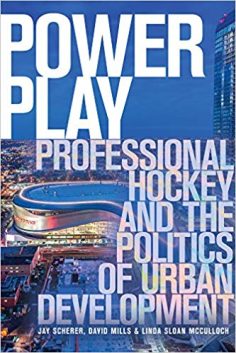How do you create a profitable, secure and much-loved professional sports franchise in a city of fewer than 300,000 people? Community ownership. This is no Rubik’s Cube. Hometown economics are the only reason they play football in Regina or Green Bay, Wisconsin. The mystery is not that Roughriders and Packers thrive but that other cities have not figured this out.
Power Play delves into the dark world of billionaire club owners, weak mayors and unconscionable subsidies that litter the world of professional sports. The names and dollar values change but these grinding sagas are all the same: One false move and the dummy gets it. Pay up or you lose the team. So, taxpayers pay and pay.
Authors document this phenomenon in a post-mortem on the Edmonton Oilers’ downtown arena. “Hundreds of millions of dollars of scarce public resources had been spent to support the business interests of a billionaire at the expense of other infrastructure needs,” says Power Play. It is instantly familiar to ratepayers in a dozen other cities.
“Readers will be all too familiar with the well-worn playbook deployed so often in recent years by the commissioners of professional sports leagues and the owners of major league sports franchises intent on extracting billions of dollars in concessions for the construction of increasingly costly and spectacular sports facilities and entertainment districts,” authors write. “Between 1990 and 2010 over 100 new facilities were built across North America, a replacement rate of more than 90 percent.”
This is a compelling account of glib boosterism, secret meetings, bland assurances from the mayor that this “wouldn’t cost the taxpayers any money”, and dog-like hometown media coverage. The Edmonton Journal in one editorial called the local arena power play a “rare and priceless opportunity”.
The Oilers briefly had something resembling community ownership until 2008 when Daryl Katz, a local pharmaceutical mogul, bought the team for $200 million. “This was a real estate play,” authors quote one city official.
Katz proceeded to extract spectacular municipal concessions to build a new downtown arena. The $613.7 million financing agreement included a twenty-year tax freeze, direct taxpayer financing, $7 million in federal subsidies, waivers on local liquor licensing, you name it.
There was no local bond issue or plebiscite. Edmonton voters had rejected hockey palace subsidies in plebiscites in 1966 and 1970. City Council never made that mistake again.
“The arena debate in Edmonton skewed municipal priorities and dominated political energies for almost a decade,” sighs Power Play: “Beyond the significant financial costs, these matters will continue to affect municipal governance for the next thirty years.”
Power Play is more entertaining than an Oilers opener and definitely cheaper than a first-tier ticket.
By Holly Doan
Power Play: Professional Hockey and the Politics of Urban Development, by Jay Scherer, David Mills and Linda Sloan McCulloch; University of Alberta Press; 464 pages; ISBN 9781-77212-4934; $32.99






